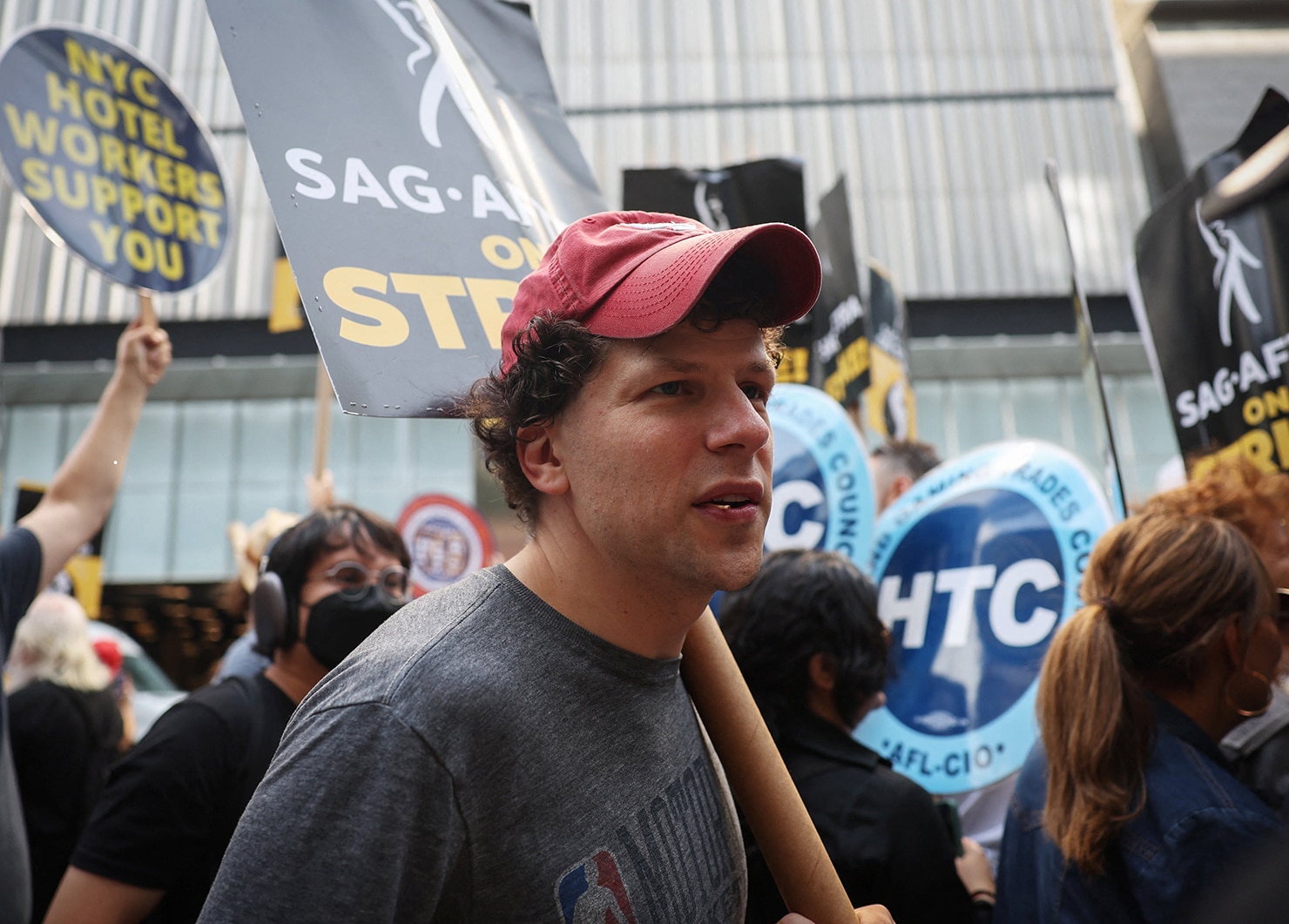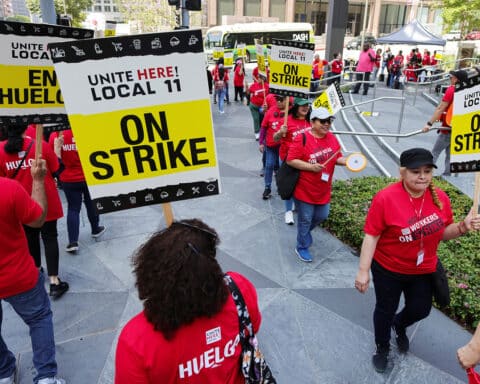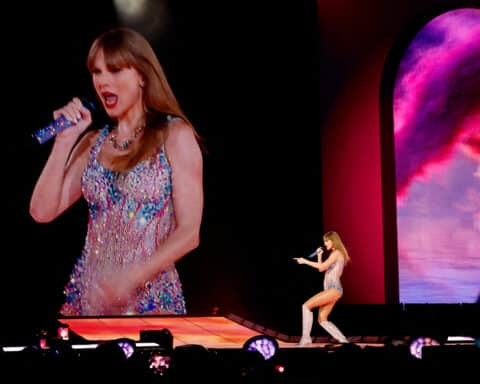(OSV News) — Less than two weeks after the United Auto Workers secured historic concessions from the nation’s “Big Three” automakers, another prominent union can claim a significant victory: the Screen Actors Guild-American Federation of Television and Radio Artists.
SAG-AFTRA ended its strike against Hollywood studios at 12:01 a.m. Nov. 9, ensuring that cameras will once again “roll” on sound stages that went dark for 118 days. Film and scripted TV ground to a halt, delaying movie releases and stopping paychecks for thousands of working actors.
What many experts called a “hot labor summer” — punctuated by coast-to-coast strikes and negotiations — may yet transition into a toasty labor autumn that witnesses gains for other job sectors, too.
Will more workers join?
But will more of America’s workers be motivated to join unions and march picket lines — actions supported by Catholic social teaching — in hopes of procuring family wages and fair working conditions, or will union membership remain at its currently anemic 10.1%?
“I think that all of these strikes and near-strikes producing pretty substantial wins for unionized workers is revealing of the sort of era we’re in,” said Daniel Graff, director of the Higgins Labor Program at the University of Notre Dame’s Center for Social Concerns.
“That post-pandemic appreciation for workers — plus the increasing uncertainty over job security, technology; just so much volatility in the labor markets; and in terms of inflation — there’s just a real sense amongst the public, and I think amongst employers, that workers have been due some gains over the last several years,” Graff told OSV News. “And I do think each time there’s a serious resolution that appears to be a win for unions, that does put more pressure on the employers, whatever the sector. These are very public labor disputes, and people are watching.”
Biggest contract in history
In its initial statement Nov. 8, the union said it had “arrived at a contract that will enable SAG-AFTRA members from every category to build sustainable careers. Many thousands of performers now and into the future will benefit from this work.”
With the largest contract-on-contract gains in the history of the union, the latest agreement includes over $1 billion in new wages and benefit plan funding; “unprecedented” provisions for consent and compensation “that will protect members from the threat of AI”; and a streaming participation bonus. Pension and health plan caps have been raised, and with them, plan value.
Actors had protested that as studios’ streaming revenues surged, their own incomes cratered due to imbalanced residual payments.
A full 86% of SAG-AFTRA’s National Board voted to approve the tentative contract, which the union’s 160,000 members will be asked to ratify or reject; voting will run until the first week of December.
Regulating AI
A critical consideration for SAG-AFTRA centered on regulation of Artificial Intelligence, or AI. Technical advances have made it possible to convincingly achieve what decades ago was only imagined, raising concerns over both ownership of an actor’s likeness, and fair compensation for its use.
Think Carrie Fisher’s post-mortem Star Wars franchise appearance in “Star Wars: The Rise of Skywalker,” generated — with her daughter’s blessing — from unused “The Force Awakens” footage featuring Fisher, who died in 2016. As Vanity Fair observed in 2019, “doing that meant more than just splicing shots from old deleted scenes into the action. The Leia (Fisher’s character) in ‘Rise’ has different hair, a different costume, and exists in an entirely different location than where Fisher shot.”
While industry-wide use of AI and CGI (computer-generated imagery) continues to accelerate, experts say the new protections are nonetheless historic — and meaningful in a changed labor environment.
“When we’re dealing with new technologies, it is as much about getting something on the table acknowledging a need for compensation as it is about getting a good number,” said Miranda Banks, an associate professor of film, television and media studies at Loyola Marymount University in Los Angeles.
“It’s about getting your foot into the door that will allow for future negotiations. But until you have jurisdiction over a particular technology, then you can’t really fight,” Banks explained. “We don’t know where the technology is going — but now the technology and systems of compensation around it can be negotiated moving forward.”
Major negotiations to come
Still, the road ahead is not without potential bumps.
“While everyone in Hollywood is breathing a huge sigh of relief — and I think there’s much to celebrate in what was accomplished in these negotiations — there’s also a lot of difficult moments ahead for Hollywood,” said Banks, “both in terms of getting ramped up and getting things back on track, and then into next year, keeping things on track as these other major negotiations start.”
Those other major negotiations on the horizon — starting as early as next year — include production staff who belong to the International Alliance of Theatrical Stage Employees, or IATSE, as well as the International Brotherhood of Teamsters, America’s largest and most diverse union in terms of job functions.
“If IATSE goes out on strike, nothing’s going to get made,” Banks emphasized. “If crew isn’t working, nobody’s working. IATSE covers every aspect of production.”
Catholic labor history
The Catholic Church has an extensive history of teaching and actions supporting the rights of workers and organized labor.
“There is no union without workers, and there are no free workers without a union,” Pope Francis told members of the Italian General Confederation of Labor in December 2022.
While strike actions can have economic impacts, the Catholic Church has nonetheless supported their necessity.
St. John Paul II in his 1981 encyclical, “Laborem Exercens” (“On Human Work”), taught labor strikes are “recognized by Catholic social teaching as legitimate in the proper conditions and within just limits. … Workers should be assured the right to strike.”
The U.S. Conference of Catholic Bishops’ 1986 pastoral letter, “Economic Justice for All,” teaches, “Unions may also legitimately resort to strikes where this is the only available means to the justice owed workers.”
When can workers strike?
“No one really wants a strike,” said Clayton Sinyai, executive director of the Catholic Labor Network, “but sometimes workers can’t get a fair shake from their employers unless they withhold their labor. As was the case a short time ago for the auto workers, the actors used their union to address serious challenges they faced in the workplace,” he observed. “The producers were not inclined to give actors or writers a fair share of new streaming rights — or employment security — in the face of AI, until they faced collective action.”
Union membership peaked in the 1950s at one-third of the workforce. As an August 2023 U.S. Department of the Treasury report indicated, “Increased unionization has the potential to contribute to the reversal of the stark increase in inequality seen over the last half century.”
While Americans overwhelmingly support unions — an August 2022 Gallup poll indicated 71% of Americans approve of labor unions, the highest number since 1965 — not all reactions to unions are positive.
“The tempering among the business side in the press — saying, ‘Unions are getting wins, but this isn’t going to last forever; and they’d better be careful’ — there’s always this sort of, let’s throw a little water on the enthusiasm,” Graff told OSV News. “Maybe out of fear that it will spread — even to the sectors where we haven’t seen serious unionization rates or major wins.”
“The truth will be — whether this is more than a moment — if this can gain traction amongst workers who are historically way more marginalized, way less secure, and further down on the income scale,” Graff said. “We are not used to a world where workers are this assertive, and unions are this aggressive.”





